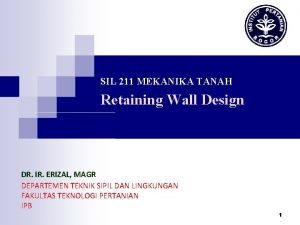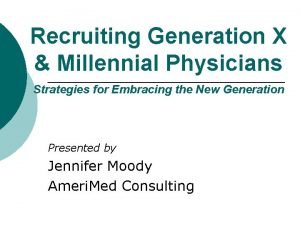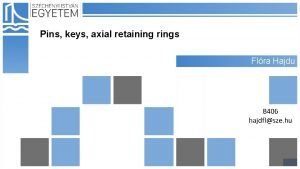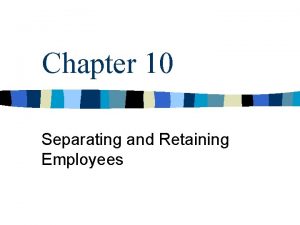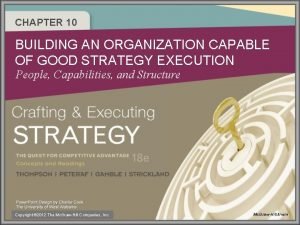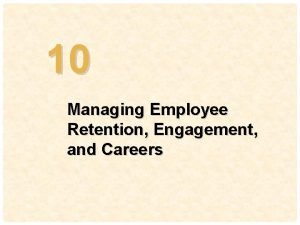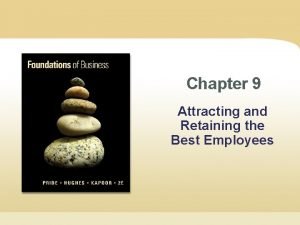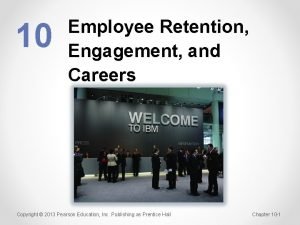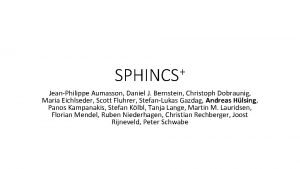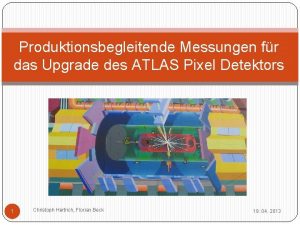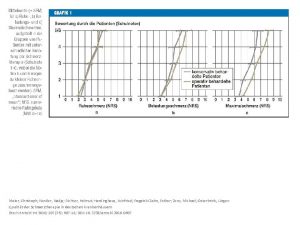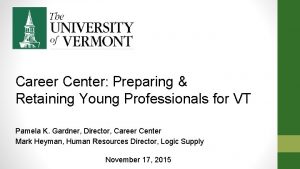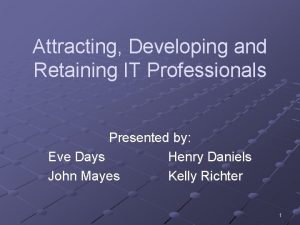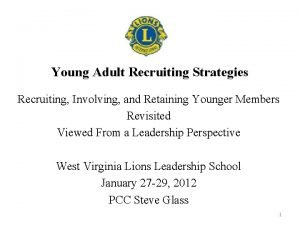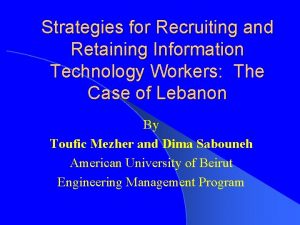Strategies for Retaining Key IT Professionals CHRISTOPH PFLGLER





















- Slides: 21

Strategies for Retaining Key IT Professionals CHRISTOPH PFLÜGLER, NICO BECKER, MANUEL WIESCHE, HELMUT KRCMAR DECEMBER 2018

BUILDING A NEURODIVERSE HIGH-TECH WORKFORCE PFLÜGLER, BECKER, WIESCHE, KRCMAR – DECEMBER 2018 Agenda • Retaining IT Professionals Is a Key Issue for IT Managers • Actions for Retaining IT Employees • Challenges of Configuring Retention Actions • Seven Types of IT Leavers and Possible Retention Strategies • Addressing the Challenges of Retaining IT Professionals • Lessons Learned for Retaining IT Professionals • Concluding Comments

BUILDING A NEURODIVERSE HIGH-TECH WORKFORCE PFLÜGLER, BECKER, WIESCHE, KRCMAR – DECEMBER 2018 Retaining IT Professionals Is a Key Issue for IT Managers • Turnover of IT professionals poses several challenges to IT organization • Finding a successor to someone who has quit is often difficult due to the high demand for skilled IT professionals in the global IT labor market • Turnover creates direct costs, such as recruiting and training, as well as indirect costs through the disruption of organizational processes • Retention process: • Weak signals about the likelihood of the employee leaving • If the probability of leaving is above a certain level, the manager can decide whether to make an effort to retain the employee • How to save an employee is not straightforward

BUILDING A NEURODIVERSE HIGH-TECH WORKFORCE PFLÜGLER, BECKER, WIESCHE, KRCMAR – DECEMBER 2018 Actions for Retaining IT Employees • Financial or Non-financial Compensation • Working Arrangements • Career Development Opportunities • Change of Department • Varying Work Tasks

BUILDING A NEURODIVERSE HIGH-TECH WORKFORCE PFLÜGLER, BECKER, WIESCHE, KRCMAR – DECEMBER 2018 Challenges of Configuring Retention Actions • Finding the right combination of retention actions for IT professionals that IT managers want to keep is challenging • Cost and time restrictions mean it may not be possible to simply try out all the actions to test which of them works • Retention actions incur costs • Retention actions take time to be effective • The combination of retention actions needs to be tailored for each IT professional

BUILDING A NEURODIVERSE HIGH-TECH WORKFORCE PFLÜGLER, BECKER, WIESCHE, KRCMAR – DECEMBER 2018 Seven Types of IT Leavers and Possible Retention Strategies • A: “I Have No Real Stock Here” • B: “This Is the Wrong Job for Me” • C: “The Job Does Not fit with My Spouse or Partner’s Needs” • D: “I Do Not Like It Here” • E: “I Need Something New” • F: “I Lack Career Development Opportunities” • G: “I Just Don’t Fit Here Anymore”

BUILDING A NEURODIVERSE HIGH-TECH WORKFORCE PFLÜGLER, BECKER, WIESCHE, KRCMAR – DECEMBER 2018 Leaver Type Original Joining Motivation A: “I Have No Real Recommendation from friend/colleague Stock Here” Table 1: Seven Types of IT Leavers Relationships Reasons for Leaving Average relationship with co-workers Insufficient non-monetary recognition Slightly poorer relationship with Lack of career opportunities supervisor Dissatisfaction with general work environment External job offer B: “This Is the Wrong Job for Me” Opportunity to work on challenging tasks Size and location of company Average relationship with co-workers Dissatisfaction with general work environment Good relationship with supervisor Lack of career opportunities Poor fit between employee and assigned task C: “The Job Does Not fit with My Spouse or Partner’s Needs” Recommendation from friend/colleague Size and location of company Very good relationships with coworkers and supervisor Dissatisfaction with work-life balance Dissatisfaction with general working environment Personal triggers related to private life D: “I Do Not Like It Recommendation from friend/colleague Here” Company culture Size and location of company Very poor relationships with coworkers and supervisor Poor working relationship with supervisor Insufficient non-monetary recognition Dissatisfaction with general working environment Lack of career opportunities Dissatisfaction with work-life balance Recommendation from friend/colleague Opportunity to work on challenging tasks Company culture Career advancement Opportunity to work on challenging tasks Recommendation from friend/colleague Size and location of company Career advancement Very good relationships with coworkers and supervisor Lack of career opportunities Dissatisfaction with work-life balance Desire for new/challenging tasks and topics Opportunity to work on challenging tasks Size and location of company Company culture Career advancement Average relationship with co-workers Various reasons and supervisor E: “I Need Something New” F: “I Lack Career Development Opportunities” G: “I Just Don’t Fit Here Anymore” Average relationship with co-workers Lack of career opportunities Very poor relationship with Poor working relationship with supervisor Dissatisfaction with general working environment Insufficient non-monetary recognition Lack of personal development and poor social interactions

BUILDING A NEURODIVERSE HIGH-TECH WORKFORCE PFLÜGLER, BECKER, WIESCHE, KRCMAR – DECEMBER 2018 Table 2: Characteristics of Type A IT Leavers Average tenure (days) 1, 990 Previously considered leaving 20% Turnover was preventable 60% Talked first to supervisor about intention to leave Reasons for joining the organization 40% Reasons for leaving Recommendation from friend/colleague (85%) Insufficient non-monetary recognition (65%) Lack of career opportunities (55%) Dissatisfaction with general work environment (25%) External job offer (response to open question)

BUILDING A NEURODIVERSE HIGH-TECH WORKFORCE PFLÜGLER, BECKER, WIESCHE, KRCMAR – DECEMBER 2018 Table 3: Characteristics Type B IT Leavers Average tenure (days) 960 Previously considered leaving 31% Turnover was preventable 81% Talked first to supervisor about intention to leave Reasons for joining the organization 56% Reasons for leaving Dissatisfaction with general working environment (93. 8%) Lack of career opportunities (31. 2%) Opportunity to work on challenging tasks (62. 5%) Size and location of company (25%) Poor fit between employee and assigned task (response to open question)

BUILDING A NEURODIVERSE HIGH-TECH WORKFORCE PFLÜGLER, BECKER, WIESCHE, KRCMAR – DECEMBER 2018 Table 4: Characteristics of Type C IT Leavers Average tenure (days) 1, 600 Previously considered leaving 16% Turnover was preventable 27% Talked first to supervisor about intention to leave Reasons for joining the organization 65% Reasons for leaving Dissatisfaction with work-life balance (27%) Dissatisfaction with general work environment (24. 3%) Different personal triggers, most of which are related to private life Recommendation from friend/colleague (84%) Size and the location of company (29. 7%) Relocation is a frequently reported

BUILDING A NEURODIVERSE HIGH-TECH WORKFORCE PFLÜGLER, BECKER, WIESCHE, KRCMAR – DECEMBER 2018 Table 4: Characteristics of Type C IT Leavers Average tenure (days) 1, 690 Previously considered leaving 50% Turnover was preventable 72% Talked first to supervisor about intention to leave Reasons for joining the organization 44% Reasons for leaving Recommendation from friend/colleague (61. 1%) Company culture (33. 3%) Size and the location of the employer (27. 8%) Supervisor (55. 6%) Insufficient non-monetary recognition (33. 3%) Dissatisfaction with general working climate (27. 8%) Lack of career opportunities (22. 2%)

BUILDING A NEURODIVERSE HIGH-TECH WORKFORCE PFLÜGLER, BECKER, WIESCHE, KRCMAR – DECEMBER 2018 Table 6: Characteristics of Type E IT Leavers Average tenure (days) 2, 210 Previously considered leaving 35% Turnover was preventable 52% Talked first to supervisor about intention to leave Reasons for joining the organization 70% Recommendation from friend/colleague (87%) Opportunity to work on challenging tasks (39. 1%) Company culture (21. 7%) Career advancement (21. 75) Reasons for leaving Lack of career opportunities (30. 4%) Work-life balance (26. 1%) Desire to work on different tasks and projects (response to open question)

BUILDING A NEURODIVERSE HIGH-TECH WORKFORCE PFLÜGLER, BECKER, WIESCHE, KRCMAR – DECEMBER 2018 Table 7: Characteristics of Type F IT Leavers Average tenure (days) Previously considered leaving Turnover was preventable Talked first to supervisor about intention to leave Reasons for joining the organization Reasons for leaving 1, 580 20% 72% 56% Opportunity to work on challenging tasks (72%) Recommendation from friend/colleague (44%) Size and location of the company (40%) Career advancement (36%) Lack of career opportunities (52%) Supervisor (32%) Dissatisfaction with general working environment (32%) Insufficient non-monetary recognition

BUILDING A NEURODIVERSE HIGH-TECH WORKFORCE PFLÜGLER, BECKER, WIESCHE, KRCMAR – DECEMBER 2018 Table 8: Characteristics of Type G IT Leavers Average tenure (days) 1, 570 Previously considered leaving 25% Turnover was preventable 50% Talked first to supervisor about intention to leave Reasons for joining the organization 58% Opportunity to work on challenging tasks (55. 6%) Size and location of company (49. 3%) Company culture (31. 2%) Career advancement (22. 9%) Reasons for leaving Lack of career opportunities (34. 7%) Work-life balance (25. 7%) A broad variety of reasons concerned with private life, salary and dissatisfaction with the current project

BUILDING A NEURODIVERSE HIGH-TECH WORKFORCE PFLÜGLER, BECKER, WIESCHE, KRCMAR – DECEMBER 2018 Addressing the Challenges of Retaining IT Professionals • Table 9 depicts how effective the five retention actions are for each of the seven types of IT employee. • Each cell shows if the action is definitely helpful (a filled circle), might be helpful (a half-filled circle) or probably not helpful (an empty circle). • We strongly recommend definitely helpful actions when trying to retain a particular type of IT employee. • Might be helpful actions could be considered, but the probability of success is lower than for those actions identified as definitely helpful. • Probably not helpful actions have a low probability of success.

BUILDING A NEURODIVERSE HIGH-TECH WORKFORCE PFLÜGLER, BECKER, WIESCHE, KRCMAR – DECEMBER 2018 Table 9: Retention Actions for Different Types of IT Employees

BUILDING A NEURODIVERSE HIGH-TECH WORKFORCE PFLÜGLER, BECKER, WIESCHE, KRCMAR – DECEMBER 2018 Figure 1: Choosing Retention Actions Is Part of the Retention Process

BUILDING A NEURODIVERSE HIGH-TECH WORKFORCE PFLÜGLER, BECKER, WIESCHE, KRCMAR – DECEMBER 2018 Employee Type A: “I Have No Real Stock Here” Table 10: Characteristics Identifying Employee Type Characteristics Identifying the Respective Employee Type Does not take ownership of problems Seeks security in career perspectives Not actively job seeking B: “This Is the Wrong Job for Me” Requests changes in job responsibilities Seeks challenging tasks Fit in social environment C: “The Job Does Not Fit with my Spouse or Partner’s Needs” Positive attitude to overtime as long as it fits private life Strong personality Changes in personal life Many complaints about working environment Poor relationship with supervisor Actively thinks about leaving Long time in same position Positive attitude to current job Seeks new tasks F: “I Lack Career Development Opportunities” Missed promotion Dissatisfied with working environment Poor relationship with supervisor G: “I Just Don’t Fit Here Anymore” Various reasons for dissatisfaction Does not respond to single retention D: “I Do Not Like It Here” E: “I Need Something New”

BUILDING A NEURODIVERSE HIGH-TECH WORKFORCE PFLÜGLER, BECKER, WIESCHE, KRCMAR – DECEMBER 2018 Lessons Learned for Retaining IT Professionals • Lesson 1: Know Your Employees • Lesson 2: Optimize Career Opportunities and the Internal Job Market • Lesson 3: Align Retention Actions to the Organizational Context • Lesson 4: Keep the Door Open • Lesson 5: Conduct Post-entry Interviews • Lesson 6: Financial Compensation Leads to Short-term Retention

BUILDING A NEURODIVERSE HIGH-TECH WORKFORCE PFLÜGLER, BECKER, WIESCHE, KRCMAR – DECEMBER 2018 Retainment Challenges Table 11: Applying the Lessons Learned to Overcome IT Employee Retention Challenges Lessons Learned for Retaining IT Professionals Evaluate which retention strategies Know your employees are effective IT employees like to work on Optimize career opportunities; diverse tasks and desire career establish an internal job market advancement Retention actions have different Align the retention actions with the requirements and consequences organizational context Some employees that have left Keep the door open for remight consider re-joining the employment organization in the future Get to know new employees early Conduct post-entry interviews on and be attuned to recognizing early on those at risk of leaving in the future Retention actions differ in their Financial compensation leads to short- and long-term effects -term retention, whereas working arrangements, career development, department change and assignment

BUILDING A NEURODIVERSE HIGH-TECH WORKFORCE PFLÜGLER, BECKER, WIESCHE, KRCMAR – DECEMBER 2018 Concluding Comments • Turnover of IT professionals is problematic for IT organizations • Efforts should be taken to reduce or prevent it • IT managers should match retention actions with reasons for leaving • We propose a strategy for retaining IT professionals, which classifies IT leavers (and employees) into seven types • We have provided advice on how IT managers can choose the most effective retention actions for each of these types • We have also identified 6 lessons that IT managers can apply as they seek to reduce turnover among their employees.
 Key partners example business model canvas
Key partners example business model canvas Contoh bisnis model canvas makanan pdf
Contoh bisnis model canvas makanan pdf Curtailment of bars in retaining wall
Curtailment of bars in retaining wall Expansion joint in retaining wall
Expansion joint in retaining wall Retaining wall function
Retaining wall function Retaining wall terminology
Retaining wall terminology Recruiting millennial physicians
Recruiting millennial physicians 406 woodruff key dimensions
406 woodruff key dimensions Length of retaining wall
Length of retaining wall Separating and retaining employees
Separating and retaining employees 10 basic tasks of the strategy execution process
10 basic tasks of the strategy execution process Foundations and earth retaining structures
Foundations and earth retaining structures K active soil
K active soil Building a timber retaining wall
Building a timber retaining wall Comprehensive approach to retaining employees
Comprehensive approach to retaining employees Attracting and retaining the best employees
Attracting and retaining the best employees Comprehensive approach to retaining employees
Comprehensive approach to retaining employees Retaining members in an organization
Retaining members in an organization Christoph luthy
Christoph luthy Andreas-christoph bernstein
Andreas-christoph bernstein Christoph hertrich
Christoph hertrich Nestler helmut
Nestler helmut



